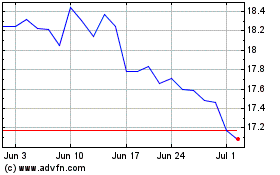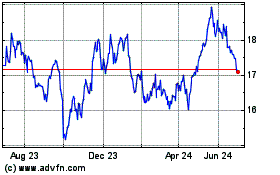PG&E's Bankruptcy Judge Opens the Door to Rival Chapter 11 Exit Plan
October 09 2019 - 6:38PM
Dow Jones News
By Peg Brickley
The judge presiding over PG&E Corp.'s bankruptcy handed
shareholders a loss, opening the door to a competition over the
best path out of bankruptcy that pits the troubled utility against
bondholders led by Elliott Management Corp.
Judge Dennis Montali of the U.S. Bankruptcy Court in San
Francisco cleared the way for a rival chapter 11 plan from Elliott
and other bondholders that are allied with victims of wildfires
that drove PG&E to bankruptcy. His ruling stripped PG&E of
the sole right to propose a chapter 11 plan covering billions of
dollars of damages from blazes linked to PG&E equipment. Shares
of the company were down 27% after hours.
The decision means at least two chapter 11 plans will move
forward as PG&E shifts into a crucial phase of its chapter 11
proceeding. The coming months will see either a deal with fire
victims or a series of judicial rulings that will produce an
estimate of how much PG&E will have to set aside to cover those
damages. PG&E didn't immediately comment on the decision.
The rival plans are about $5 billion to $6 billion apart on
where they think that number will fall. Wall Street banks and hedge
funds from California to Connecticut are placing their bets,
cutting deals to finance PG&E's chapter 11 plan, the
bondholders' rival plan or both.
The bondholders proposed a plan to raise new money and use all
but a sliver of PG&E equity to pay off debts, while the company
favors raising both debt and equity financing to dig itself out of
chapter 11 and prevent shareholders from taking a bigger hit.
The San Francisco utility has faced criticism from regulators
and consumer advocates for years for skimping on safety while
paying out shareholder dividends. The dividends stopped before
bankruptcy, and PG&E's chapter 11 plan would dilute existing
shareholders if it makes it through bankruptcy court and past the
California Public Utilities Commission.
PG&E's plan is more protective of shareholders than the
bondholder plan, which was put together in an alliance with fire
victims who said the utility wasn't treating them fairly. At a
court hearing Monday, backers of PG&E's strategy said the
bondholder plan was the equivalent of a hostile takeover of the
company.
Bondholders, backed by most of PG&E's creditors, said it
makes sense to have multiple options on the table as the company
races to hit a June 2020 deadline to exit bankruptcy. Missing the
deadline would cost PG&E the chance to participate in a
statewide fund established to cushion California utilities against
rising wildfire risks.
What actually happens to the value of PG&E's shares will be
determined by the outcome of a judicial process designed to assign
a dollar figure to liabilities from blazes that claimed more than
100 lives and wiped out thousands of homes and businesses.
Judges in state, federal and bankruptcy courts are handling
different elements of the process, but the end game is to name the
number that PG&E has to put into a trust to cover damages owed
to people who lost homes, livelihoods and loved ones to the
fires.
PG&E pegs its debts to people, state firefighters and
federal emergency management agencies at about $8.4 billion. If the
court-supervised damages estimate comes in at about that number,
PG&E's chapter 11 plan will work out.
At that level, big shareholders and Wall Street investors are
standing by to invest fresh cash in the company, some of it in
equity, some of it in debt, the company's lawyers said at Monday's
hearing in the U.S. Bankruptcy Court in San Francisco. If the
figure goes somewhat higher, PG&E may have to reconfigure its
financing, but the chapter 11 plan will still work, according to
backers of the company's plan.
The higher the fire damages estimate moves, the less value is
left for shareholders, who are at the bottom of the payment
priority scheme established in bankruptcy.
If the estimate of fire damages hits a certain point, PG&E
could be deemed insolvent, meaning shareholders could be wiped out.
Dennis Dunne, lawyer for an official committee representing nonfire
creditors, said he feared that a high damages estimate will cause
big shareholders to "tap out" and refuse to fund PG&E's
bankruptcy plan.
Cecily Dumas, lawyer for the fire-damage committee, said at
Monday's hearing that if the estimation process produces a figure
that is above the $13.5 billion mark, PG&E could be tipped into
insolvency, and that is something the fire victims want to avoid.
So even if the damages estimate comes in higher than $13.5 billion,
the committee will still honor its agreement to jointly sponsor the
bondholder plan, she said.
PG&E has accused fire victims of trying to get more than
they are owed. Ms. Dumas said the victims won't ask for
overpayment.
Both proposed chapter 11 plans provide $11 billion for insurers
that paid fire claims and investors that bought those claims,
chiefly the Baupost Group LLC, a Boston hedge fund. Both also stand
to honor a $1 billion settlement with the city of Paradise, Calif.,
and other government bodies that sustained fire damage.
Write to Peg Brickley at peg.brickley@wsj.com
(END) Dow Jones Newswires
October 09, 2019 18:23 ET (22:23 GMT)
Copyright (c) 2019 Dow Jones & Company, Inc.
PG&E (NYSE:PCG)
Historical Stock Chart
From Mar 2024 to Apr 2024

PG&E (NYSE:PCG)
Historical Stock Chart
From Apr 2023 to Apr 2024
